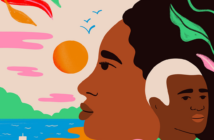Patients and future physicians find a creative outlet.
Medicine—not only treatments and the underlying science but also components of bioethics, economics, anthropology, and other social sciences—is a point of discussion among medical providers, patients with lived experiences, and communities at large.
During her sophomore year, Jane Zafran ’23 envisioned a platform where these perspectives could be shared more widely at Brown. Her classmates Nathalie Felton ’23, Elyse Forman ’23, and Jason Peres Da Silva ’23 agreed, so they started meeting over Zoom during the pandemic to co-found the Brown Journal of Medical Humanities.
The inaugural issue, published last spring, features creative and nonfiction writing, artwork, and podcasts from RISD and Brown faculty and undergraduate, graduate, and medical students. Topics range from narrations of individuals’ personal experiences with medicine and the medical system to objective reporting on the state of medicine and its history. “We really wanted it to feel like a forum where all voices were heard,” says Zafran, a former co-editor-in-chief.
While a few other universities have journals focused on the medical humanities, this is Brown’s first. The open curriculum and many students’ interdisciplinary interests fit well with the journal’s purpose, says Felton, also a former co-editor-in-chief.
The founders wanted the journal to be open to a range of contributors and readers. “It’s so important to listen to people’s stories, especially people’s stories [that]wouldn’t otherwise be heard,” says Forman, former director of the journal. “One of the main things we wanted to accomplish was trying to hear the stories of people from marginalized communities, of people who otherwise might have been ignored or silenced.”
Felton adds in an email, “We wanted to place an emphasis on viewing patients not just as their diseases but as people who are experiencing illness and everything that that entails beyond just what’s physically happening in their bodies.”
In addition to curating pieces for publication, the editorial team built an in-person community. Forman led a visit to the RISD Museum for any students interested in the medical humanities to discuss the intersections between featured artwork and medicine. The team also held a party to celebrate the journal’s launch.
One key partner is Brown’s Cogut Institute for the Humanities, which has hosted a lecture series on creative medicine, and funded BJMH and offered editing and publishing advice. “It was wonderful—the passion that [the founders]brought to this project was already evident even before the launch of this first issue,” says Gregory Kimbrell, MFA, the institute’s communications manager.
In April the BJMH published its second issue in print and online. “There’s just so much richness in the submissions we received this year, both in written pieces and in art,” says Samantha Alzate ’24, co-editor-in-chief along with Byron Butaney ’25.
The journal is for everyone, because everyone will at some point be a patient, a caregiver, or both, Felton notes. “Health-related stories are important for everyone to hear—not just people in the medical field,” she writes.




